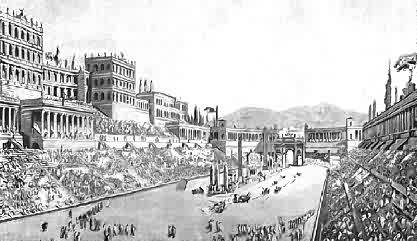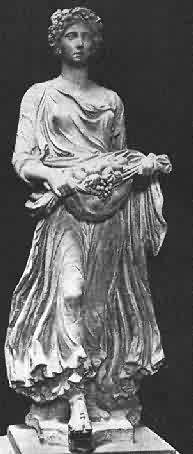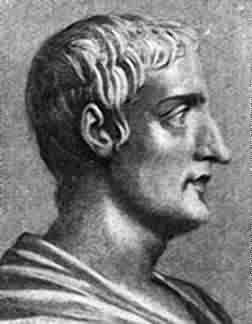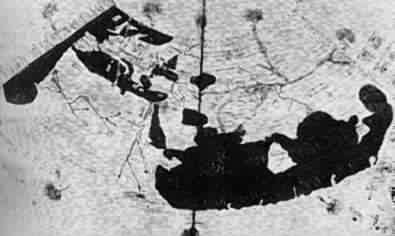
MARCH OF THE TITANS - A HISTORY OF THE WHITE RACE
CHAPTER 13 : THE GLORY OF ROME
The fact that the Roman Empire dissolved into a multi-racial polyglot does not distract from the very many fine cultural and engineering achievements of the original Romans. It is however very noticeable that the greatest Roman achievements date from before the time of the racial dissolution of the empire - once again mirroring earlier civilizations.
ROMAN SOCIAL LIFE
Roman social life concentrated on great athletic and sporting events. The tradition of blood sports - of gladiators killing each other for the amusement of spectators, was not a sport associated with the original Romans.
It only became common once Rome had started to fill up with foreigners, although there was certainly no active resistance amongst the original Romans to the rise of the bloody spectacles. Indeed, the attraction to blood sports was also used as a political tool - very often prisoners who had been guilty of some particularly heinous crime would be fed to the lions, as often happened with the early Christians under the emperor Nero.
Wrestling and chariot racing were all major amusements. The largest sports stadium in Rome was the Circus Maximus, which could seat approximately 300,000 people and could be filled with water to re-enact sea battles between regular sized ships. The Circus Maximus stood for centuries, but its stone was eventually broken up for use in Christian buildings in the Middle Ages. Virtually every major Roman town, from North Africa right through to the Near East, boasted a theater or amphitheater - some in use to this day.

The huge Circus Maximus in Rome. This was the greatest Roman entertainment complex of all time, being able to seat 300,000 spectators. The first parts of the Circus Maximus were built around 600 BC, being substantially enlarged by Julius Caesar, who also added canals which could flood the theater floor upon which ships could be sailed to re-enact sea battles. The Roman general Pompey the Great is said on one occasion (55 BC) to have sponsored five days of circus games during which 500 lions and 20 elephants were killed. The Circus Maximus, which was far larger than the famous Colosseum, did not survive. It was broken up and its stone was used to build Christian churches after that religion came to dominate Europe.
ROMAN RELIGION
The one outstanding feature of Roman religion before the advent of Christianity was that there was no single faith or belief. The religious world of Rome reflected in many ways the actual empire itself: a mix of different cults and beliefs, with influences from Greece and the Middle East, all thrown in for good measure.
Many of the oldest Roman gods reflected also the nature of the first Romans - these gods represented the practical needs of daily life and military prowess. Janus and Vesta guarded the door and hearth; Lares protected the field and house; Pales the pasture; Saturn the sowing; Ceres the growth of the grain; Pomona the fruit; and Consus and Ops the harvest.
Many of these gods' names are remembered in modern day names for certain types of fruit and cultivated crops.

A Roman statue of Pomona, the goddess of fruit and Autumn. The goddess of the orchards, she was typically depicted with plentiful fruit. Her name is typical for early Roman religion: an extraction from the Latin word for apple, pomum.
Jupiter, the ruler of the gods, was not only credited with bringing rain, but was also known for his weapon, lightening (as was the Greek chief God, Zeus) and was the protector of the Romans in their military activities beyond the borders of their own community.
Mars was a god of young men and war and along with Jupiter, Quirinus, Janus and Vesta, formed the first Roman pantheon of gods.
As part of their policy of absorption, neighboring native gods from conquered surrounding lands were usually granted the same honor with which the Roman gods were held. In many cases formal invitations were made to the religions' leaders and their precious objects to take up residence in Rome. This growth in the number of foreign religions had another serious consequence - foreigners were attracted to the city in ever increasing numbers. Gods from neighboring tribes in Italy which became Roman gods included famous non Roman deities such as Diana, Minerva, Hercules and Venus. The Roman religious calendar also reflected Rome's willingness to absorb foreign cults.
The oldest Roman festivals lasted till the very end of the pagan Roman era, and marked the original Indo-European festivals of Spring and Winter.
One of the most important festivals was the Saturnalia which was celebrated for seven days, from December 17 to 23, during the original winter solstice time. All business was suspended, slaves were given temporary freedom and gifts were exchanged.
Another important festival was the Lupercalia, which celebrated Lupercus, a pastoral god. The festival was celebrated on February 15 at the cave of the Lupercal on the Palatine Hill, where the legendary founders of Rome, Romulus and Remus, were supposed to have been nursed by a she wolf.
The Equiria, a festival in honor of Mars, was celebrated on February 27 and March 14, traditionally the time of year when new military campaigns were prepared.
The growth in the number of temples in Rome also indicated how willing the Romans were to allow all manner of cults to flourish under their rule. Roman society adopted the fairly liberal approach that each person could conduct their own particular religion as they wished as long as it did not disturb the public order.
This, combined with the huge areas which fell under Roman domination, saw any number of cults and beliefs stream into Rome from all parts of the known world: Mithraism from Iran, Judaism from Palestine, and even the worship of the Isis cult from Egypt proved to be popular after Cleopatra VII visited Rome for a year as the guest of Caesar. Influences from far and wide all competed for converts in Rome.
Eventually the Romans started to deify their own great leaders after their deaths: in this way a cult around Julius Caesar and Octavian Augustus quickly grew, and temples for these groups were also built. (This is where the Catholic Church inherited the habit of deifying their most famous members, calling them saints).
All the non-Christian religions were prohibited in AD 392 by an edict of Emperor Theodosius after Christianity had become dominant.
ROMAN LITERATURE
Culturally, the early Romans left a massive heritage, contributing to Western Civilization some of the most famous writers and thinkers outside of Classical Greece.


Left: Virgil (70 BC - 19 BC) is known as the greatest of all Roman poets, mainly because of his epic poem the Aeneid, which told the story of Aenus, who moved from Troy to Italy and helped establish the Latini people. Right: The great Roman historian Tacitus (55 - 117AD), who, along with Pliny, was one of Rome's greatest historians and social commentators.
Under Roman rule, the remnant Macedonians in Egypt kept up their scientific research work started under the Ptolomies. Under the Romans, Alexandria was once again built up into a huge city, spawning the famous geographer Ptolemy (circa 200 AD) who was the first to draw a map of the world onto a curved surface, working off plans drawn up by the original White Greek Macedonian, Erastosthenes.
Galen (139 AD -200 AD) was another Romanized Greek, who established the principles of medicine used in Europe until the early Renaissance period.

The first map to represent the earth on a curved surface (and hence part of a globe) - devised by the Roman-Greek scientist Ptolemy, working in Roman Egypt during the 2nd century AD.
ART - SET WORLD STANDARDS
As with many things architectural, early Roman art copied Grecian forms. This was readily apparent in the sculpture style, and indeed many statues of Greeks which have survived to the present day are Roman copies of Greek originals.
Roman art has unquestionably set the standard against which all other art is measured - even to the point where an object or style is known as "classical" or not - an indication that even 2,000 years later, no-one has been able to improve upon the design of the Romans.

Venus de Milo, circa 150 BC.
ARCHITECTURE
The Romans unashamedly took many building designs from the Greeks (the various column types and the now famous Greco-Roman building style of a triangular roof set atop rows of columns) and perfected and added to them, creating structures which to this very day are awe inspiring and unequaled in sheer aesthetics. The Greek influence went beyond architecture. All educated Romans were bilingual, speaking Latin and Greek.
Many of the buildings in Rome itself date from the height of the Empire, and while most have been abandoned, some Roman structures, such as the famous water aqueduct in Segovia, Spain, are still working today, nineteen centuries after they were built. Roman roads were the autobahns of their day, and the road system set up by the Romans was not equaled until the twentieth century.

The Colosseum, Rome. Completed in 81 AD, it is called the Colosseum after a colossal statue of Nero that once stood nearby - its real name is the Flavian Amphitheater. It was used for staged battles, sometimes between lions and Christians and other heretics, among other spectacles, and is one of the most famous pieces of architecture in the world.

The Roman built aqueduct at Segovia in Spain, still supplies that town's water, nearly 1,800 years after it was built.
The workmanship which went into many of the constructions of the time would be hard to match even in the modern era - and this in spite of the advantage of modern tools. The Romans certainly started town planning as a skill: laying out new cities on a gird pattern for ease of commuting, and their inventions of concrete and the vaulted dome made possible the huge buildings later to become known as cathedrals.
However, this frenzied building activity, like its Egyptian predecessor, had its price. Masses of slaves provided the cheap labor to build these edifices, and the influx of slaves combined with natural immigration to the Roman center was ultimately to provide the demographic shift which brought about the Empire's downfall.
SLAVES
Slavery was an institutionalized part of Roman society. The sheer size of the Empire meant however that many slaves were foreign - Greek slaves were held to be the best type of slave to have (they were of course the Whitest slave, after Gauls or Germans, who were less common as slaves). Arabs, Blacks and others of mixed race from the Middle and Near East also made up a huge number of the slave population.
The importation of these racially alien slaves impacted upon the demographics of Rome over a period of time. The numbers of slaves must have been tremendous: there were enough of them to form their own 70,000 strong army, as happened in 73 BC, when the slave leader Spartacus led the famous slave uprising. It took an entire Roman army to suppress that uprising - but still the practice of slavery continued, and was to ultimately cost the Romans their very existence itself.
or back to
or
All material (c) copyright Ostara Publications, 1999.
Re-use for commercial purposes strictly forbidden.